
Mid-April has arrived. And along with the spring sunshine, that means the often dreaded civic duty of finishing off one’s taxes.
It’s an arduous time for many, characterized by navigating increasingly confusing rules to arrive at the best refund possible. For some, it means writing a check to the federal government. Not fun.
On a brighter note, the tax deadline has been pushed back to April 18 this year, giving those leaving it to the last minute a few extra days. Usually, the day falls on April 15.
But why is Tax Day in April anyway? Well, it hasn’t always been.
The federal individual income tax was permanently enacted by the 16th Amendment in 1913. Before that, the only federal individual income tax that existed was in place for about a decade beginning in 1861 to ease the financial burden of the Civil War on the government.
Extending the deadline
The tradition of filing tax returns in early spring has historically been a practical one. Since individual tax returns encompass a calendar year, Congress sought to allow time for individuals to fully account for all of their income, deductions and credits.
The original due date for individual income tax returns was March 1, just over a year following the adoption of the 16th Amendment on Feb. 3, 1913.
Back then, not many taxpayers needed to file a tax return, since the filing requirement applied only to single filers with income over US$3,000 and married filers with income over $4,000 – about $90,000 and $120,000 in today’s dollars, respectively.
In 1914, this threshold represented approximately the top 4% of earners, so filing a tax return was a burden reserved for the wealthy.
Quickly realizing that many taxpayers needed more time to complete their returns, Congress pushed the tax deadline back to March 15, effective in 1919.
And on that date Tax Day stood for over 30 years.
But with more taxpayers needing to file returns as the filing threshold declined and the tax laws grew in complexity, Americans needed even more time to correctly complete their returns.
So in 1954, Congress overhauled the tax system and adopted a major revision to the Internal Revenue Code.
This change also came with another extension of the tax deadline for individuals, pushing the due date back again to the familiar April 15.
The intent of giving taxpayers an extra month to prepare their returns was to allow more people the ability to file on time – and often get refunds more quickly. Not only did this change assist taxpayers, but it also allowed the Internal Revenue Service more time to spread out its workload.
The April 15 deadline proved to be a more reasonable deadline, and it has stuck with U.S. taxpayers for almost 70 years.
Since 1955, the IRS has established earlier due dates for many information returns that provide numbers feeding into Form 1040, such as Forms 1099 and W-2, both of which are due Jan. 31, to ensure that most taxpayers are able to file by Tax Day.
In 2016, the IRS pushed the due date of other returns forward a month to March 15, again in an effort to allow more individuals to timely file.
So why later this year?
The mid-April date seems to work for the majority of taxpayers – in most years, anyhow. According to the IRS, about 90% of taxpayers were able to file their returns by the deadline in 2021, with the other 10% requesting a six-month extension to file.
But for the tax year 2022, about 19 million taxpayers extended their returns, a significant increase from prior years due to the increased complexity of the tax code brought on by temporary provisions relating to the COVID-19 pandemic.
So why is Tax Day this year April 18 instead of April 15?
Any time a deadline falls on a Saturday or Sunday, the IRS pushes the due date to the following Monday, which would be April 17, 2023. However, any federal holiday also pushes the date back by a day. Since Emancipation Day, which usually falls on April 16, is observed in Washington, D.C., on April 17 this year, Tax Day was pushed back an additional day to Tuesday, April 18, 2023.
While having a tax deadline of April 18 happens only about every six years, the IRS occasionally pushes back the filing deadline for emergency situations like natural disasters, although these are often local. For example, the IRS extended the original due date of individual tax returns in disaster areas in Alabama, California and Georgia until Oct. 16, 2023. Similarly, the IRS pushed the national deadline back to July 15, 2020, in the early stages of the COVID-19 pandemic.
So use your extra days of tax preparation time wisely in 2023 and be sure to file your individual income tax return, or request an extension to file by April 18.
Although this time of year can often be stressful and confusing because of complicated tax laws, it will be over soon enough.
Thomas Godwin does not work for, consult, own shares in or receive funding from any company or organization that would benefit from this article, and has disclosed no relevant affiliations beyond their academic appointment.
This article was originally published on The Conversation. Read the original article.







